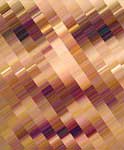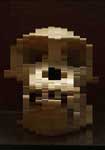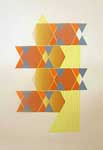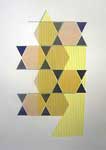March 27 - April 26, 2008
Anne Schaefer’s work explores the opportunity for endless variables within limited modular systems. Through the manipulation of large-scale repeat pattern designs in space, Schaefer seeks to produce distinctive environments by inserting novelty into order. This is achieved through manipulation of repeat intervals and color assignment, scale shifts of the repeated unit, and the addition of collaged, hand printed and three-dimensional elements. The resulting imagery is affixed directly to the wall in order to capitalize on the potential for the imagery to fuse with the architecture and create an immense perceptual experience.
Alex Haas’ new work, Symbology, continues the Histograms begun in 2001. "Histograms" is his term for works created by abstracting minute details from photographs. The latest work uses a similar method, however the result also reflects basic elements, allowing representation. The subjects rendered are portraits and urban landscapes. The subjects explored refer to man’s relationship to himself, to history, and to his surroundings in the age of technology. In order to explore this, Haas created a visual filter - a sort of digital kaleidoscope - through which only basic elements of representation remain. He chose a linear graphic reminiscent of the bar code as inspiration, representing one of the first widely used man-made systems that can only be machine read. This mapping between messages and barcodes is referred to as "symbology", a way to establish conceptual connections between behavioral psychology and mathematics. This existential ambiguity informs Haas’ new work, simultaneously representational and abstract.
Romain Erkiletlilan’s paintings represent the totality of his process, which includes photographs, retouched photographs, and drawings on vellum. All of those creative steps together become the essence of the work, each step nourishing the other. The visual chaos and confusion in the Japanese urban landscape is here abstractly reorganized and recycled into a new reality. Through impossible perspectives, colors and the use of different pictoral languages, that new reality creates an unidentified unity of form, architecture, space and time. These lines, flat surfaces, pointillism, and particular patterns create a plethora of little universes that seem to exist by themselves inside the paintings, but eventually become all together a coherent ensemble.



